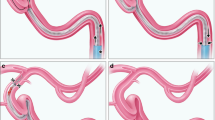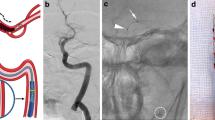Abstract
Objective
The aim of this study was to evaluate the safety and efficacy of a manually expandable stent retriever (Tigertriever, Rapid Medical, Yoqneam, Israel) in the treatment of acute ischemic stroke caused by intracranial large vessel occlusions (LVO).
Methods
We performed a single center retrospective analysis of all patients treated by mechanical thrombectomy due to LVO using the Tigertriever. The angiographic and clinical success was evaluated by the modified thrombolysis in cerebral infarction score (mTICI) and the modified Rankin score (mRS).
Results
A total of 68 acute intracranial arterial occlusions in 61 patients (42 female, median age 77 years, range 43–92 years) were treated by mechanical thrombectomy using the Tigertriever. The overall successful reperfusion rate (mTICI 2b-3) was 85.3% (58/68 occlusions) with a first pass effect (mTICI 3) of 23.5% (16/68 occlusions). In 57 of the 68 occlusions the Tigertriever was used on an intention to treat approach with a success rate of 86.0% and in the 11 remaining occlusions where the Tigertriever was used as a bail-out device the success rate was 81.9%. In seven patients a mild subarachnoid hemorrhage occurred (11.5%) and one symptomatic intracerebral hemorrhage was observed (1.6%). At discharge 39.3% of the patients (24/61) had a favorable outcome (mRS 0–2).
Conclusion
The Tigertriever offers a safe and effective treatment option in ischemic stroke due to LVOs with reperfusion rates and a safety profile similar to alternative devices. The Tigertriever is a promising bail-out tool in complex cases. Its role as a first line device has to be evaluated in further prospective studies.


Similar content being viewed by others
Abbreviations
- CT:
-
Computed tomography
- ENT:
-
Embolism in new territory
- F:
-
French
- ICA:
-
Internal carotid artery
- IVT:
-
Intravenous thrombolysis
- LVO:
-
Large vessel occlusion
- mTICI:
-
Modified thrombolysis in cerebral infarction
- NIHSS:
-
National Institutes of Health Stroke Scale
- PTA:
-
Percutaneous transluminal angioplasty
- SAH:
-
Subarachnoid hemorrhage
- sICH:
-
Symptomatic intracerebral hemorrhage
- VA:
-
Vertebral artery
References
Berkhemer OA, Fransen PS, Beumer D, van den Berg LA, Lingsma HF, Yoo AJ, et al. A randomized trial of intraarterial treatment for acute ischemic stroke. N Engl J Med. 2015;372:11–20.
Bhogal P, Andersson T, Maus V, Mpotsaris A, Yeo L. Mechanical thrombectomy. A brief review of a revolutionary new treatment for thromboembolic stroke. Clin Neuroradiol. 2018;28:313–26.
Goyal M, Menon BK, van Zwam WH, Dippel DW, Mitchell PJ, Demchuk AM, et al. Endovascular thrombectomy after large-vessel ischemic stroke: a meta-analysis of individual patient data from five randomized trials. Lancet. 2016;387:1723–31.
Campbell BCV, Donnan GA, Lees KR, Hacke W, Khatri P, Hill MD, et al. Endovascular stent thrombectomy: the new standard of care for large vessel ischemic stroke. Lancet Neurol. 2015;14:846–54.
Powers WJ, Derdeyn CP, Biller J, Coffey CS, Hoh BL, Jauch EC, et al. American Heart Association/American Stroke Association focused update of the 2013 guidelines for the early management of patients with acute ischemic stroke regarding endovascular treatment: a guideline for healthcare professionals from the American Heart Association/American Stroke Association. Stroke. 2015;46:3020–35.
Aguilar Perez M, Miloslavski E, Fischer S, Bäzner HJ, Henkes H. Intracranial thrombectomy using the Solitaire stent: a historical vignette. J Neurointerv Surg. 2012;4:e32.
Zaidat OO, Castonguay AC, Nogueira RG, Haussen DC, English JD, Satti SR, et al. TREVO stent-retriever mechanical thrombectomy for acute ischemic stroke secondary to large vessel occlusion registry. J Neurointerv Surg. 2018;10:516–24.
Maus V, Henkel S, Riabikin A, Riedel C, Behme D, Tsogkas I, et al. The SAVE Technique: large-scale experience for treatment of intracranial large vessel occlusions. Clin Neuroradiol. 2019;29:669–76.
Nikoubashman O, Wischer D, Hennemann HM, Sandmann J, Sichtermann T, Müschenich FS, et al. Balloon-guide catheters are needed for effective flow reversal during mechanical thrombectomy. AJNR Am J Neuroradiol. 2018;39:2077–81.
Fischer S, Weber A, Carolus A, Drescher F, Götz F, Weber W. Coiling of wide-necked carotid artery aneurysms assisted by a temporary bridging device (Comaneci): preliminary experience. J Neurointerv Surg. 2017;9:1039–97.
Zaidat OO, Yoo AJ, Khatri P, Tomsick TA, von Kummer R, Saver JL, et al. Recommendations on angiographic revascularization grading standards for acute ischemic stroke. Stroke. 2013;44:2650–63.
Maus V, Styczen H, Liman J, Maier I, Brehm A, Tsogkas I, et al. Intracranial mechanical thrombectomy of large vessel occlusions in the posterior circulation using SAVE. BMC Neurol. 2019;19:197.
Sheen JJ, Kim YW. Paradigm shift in intra-arteriel mechanical thrombectomy for acute ischemic stroke: a review of randomized controlled trials after 2015. J Korean Neurosurg Soc. 2020. https://doi.org/10.3340/jkns.2019.0151.
Haussen DC, Rebello LC, Nogueira RG. Optimizing clot retrieval in acute stroke: the push ant fluff technique for closed cell stenttrievers. Stroke. 2015;46:2838–42.
Wenger KJ, Nagl F, Wagner M, Berkefeld J. Improvement of stent retriever design and efficacy of mechanical thrombectomy in a flow model. Cardiovasc Intervent Radiol. 2013;36:192–7.
Machi P, Jourdan F, Ambard D, Reynaud C, Lobotesis K, Sanchez M, et al. Experimental evaluation of stent retrievers’ mechanical properties and effectiveness. J Neurointerv Surg. 2017;9:257–63.
Kara B, Selcuk HH, Erbahceci Salik A, Zalov H, Yildiz O, Gul G, et al. Single-center experience with the Tigertriever device for the recanalization of large vessel occlusions in acute ischemic stroke. J Neurointerv Surg. 2019;11:455–9.
Kara B, Selcuk HH, Yildiz O, Cetinkaya D. Revascularization of acute basilar artery occlusion using the Tigertriever adjustable clot retriever. Clin Neuroradiol. 2017;27:241–3.
Maekawa K, Shibata M, Nakajima H, Mizutani A, Kitano Y, Seguchi M, et al. Erythrocyte-rich thrombus is associated with reduced number of maneuvers and procedure time in patients with acute ischemic stroke undergoing mechanical thrombectomy. Cerebrovasc Dis Extra. 2018;8:39–49.
Schwaiger BJ, Kober F, Gersing AS, Kleine JF, Wunderlich S, Zimmer C, et al. The pREset stent retriever for endovascular treatment of stroke caused by MCA occlusion: safety and clinical outcome. Clin Neuroradiol. 2016;26:47–55.
Yoon W, Jung MY, Jung SH, Park MS, Kim JT, Kang HK. Subarachnoid hemorrhage on a multimodal approach heavily weighted toward mechanical thrombectomy with Solitaire stent in acute stroke. Stroke. 2013;44:414–9.
Balami JS, White PM, McMeekin PJ, Ford GA, Buchan AM. Complications of endovascular treatment for acute ischemic stroke: prevention and management. Int J Stroke. 2018;13:348–61.
Funding
This research received no specific grant from any funding agency in the public, commercial or not-for-profit sectors
Author information
Authors and Affiliations
Contributions
Lena Will: data acquisition, analysis and interpretation, writing of the manuscript. Volker Maus: critical review of the work. Cristoph Maurer: critical review of the work. Anushe Weber: critical review of the work. Werner Weber: critical review of the work. Sebastian Fischer: conception and design of the study, data acquisition, analysis and interpretation, writing of the manuscript, final approval of the manuscript
Corresponding author
Ethics declarations
Conflict of interest
S. Fischer: support for travel to meetings. L. Will, V. Maus, C. Maurer, A. Weber and W. Weber declare that they have no competing interests.
Additional information
Data and material are available on reasonable request from the corresponding author.
Rights and permissions
About this article
Cite this article
Will, L., Maus, V., Maurer, C. et al. Mechanical Thrombectomy in Acute Ischemic Stroke Using a Manually Expandable Stent Retriever (Tigertriever). Clin Neuroradiol 31, 491–497 (2021). https://doi.org/10.1007/s00062-020-00919-w
Received:
Accepted:
Published:
Issue Date:
DOI: https://doi.org/10.1007/s00062-020-00919-w




